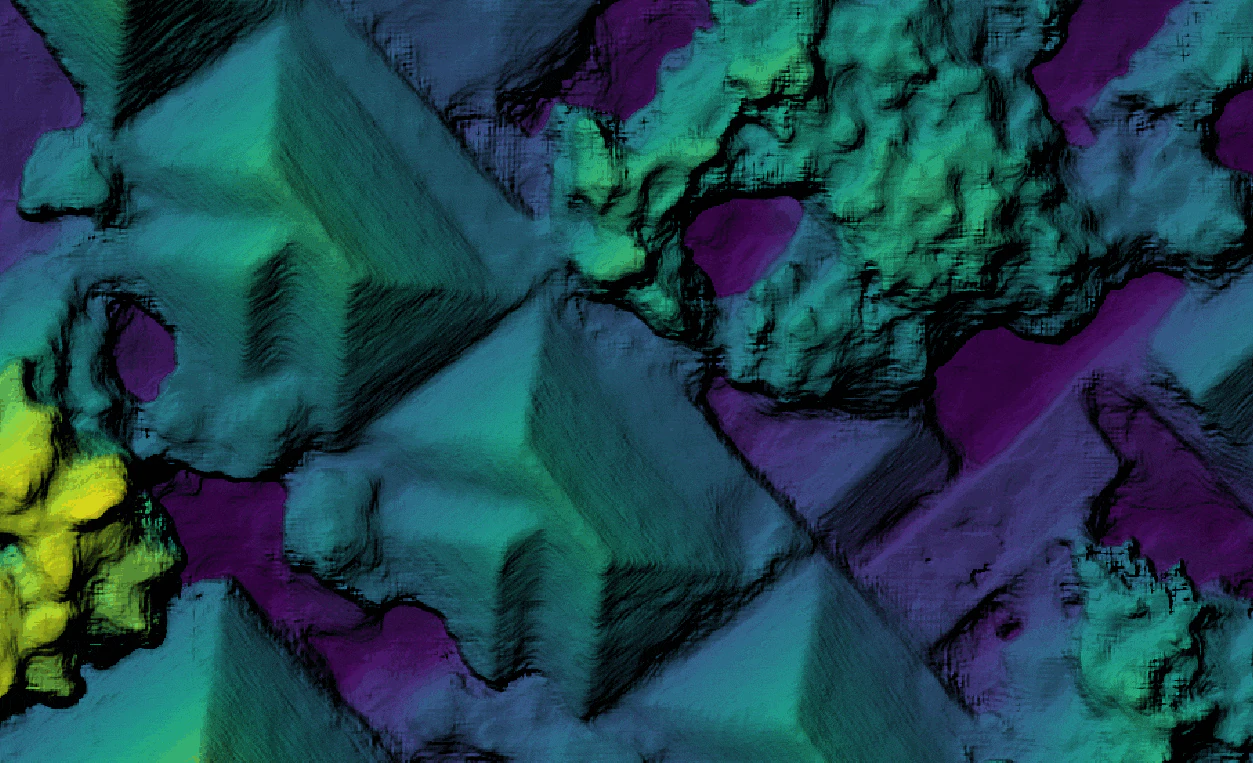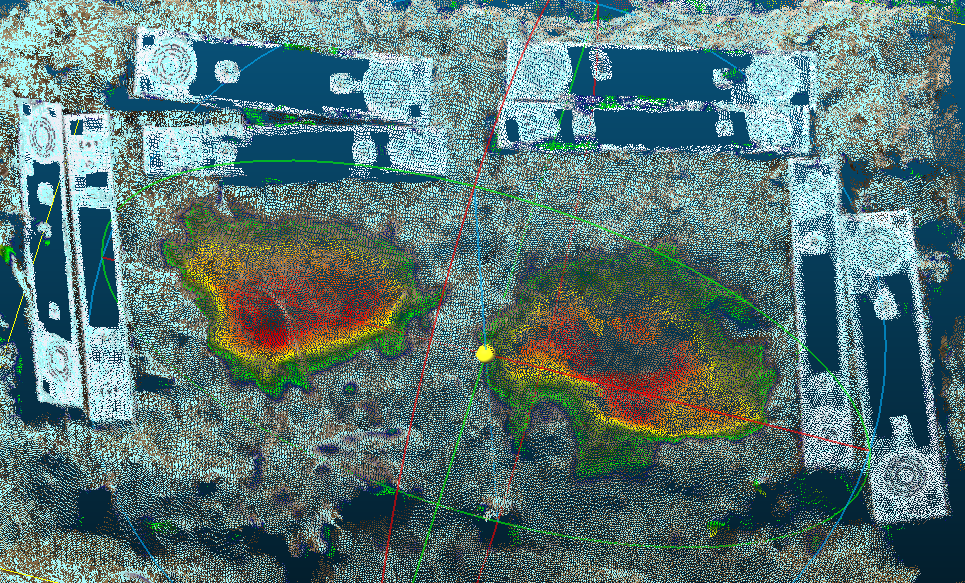High Precision Workflows
Précision de la carte
La précision peut être définie comme le degré ou la proximité avec laquelle les informations sur une carte correspondent aux valeurs du monde réel. Par conséquent, lorsque nous parlons d’exactitude, nous parlons de qualité des données et du nombre d’erreurs contenues dans un certain ensemble de données (Pascual 2011).
Précision relative ou locale
La précision locale ou relative peut être définie comme le degré auquel les distances entre deux points sur une carte correspondent aux distances réelles entre ces points dans le monde réel.
La précision relative est indépendante de l’emplacement de la carte dans le monde, donc une carte peut avoir une précision relative élevée (en taille et en forme) mais sa position dans le monde peut être décalée (Figure 1).

Figure 1. Modèle montrant une précision relative élevée mais mal placé par rapport à sa position réelle dans le monde
Précision absolue ou globale
La précision absolue est la précision de la reconstruction par rapport à sa position réelle sur la planète (Pix4D 2019). La figure 2 montre un modèle de précision relative et absolue, car les points sont correctement placés en fonction de sa position dans le monde réel.

Figure 2. Modèle montrant une précision relative et absolue élevée. Placé correctement en fonction de sa position réelle dans le monde
Un niveau de précision pour chaque projet
Chaque projet a une précision spécifique qui doit être respectée. Par exemple, évaluer l’avancement d’un chantier de construction ou mesurer une zone touchée par un incendie ne nécessite pas l’utilisation de GCP, car une précision absolue n’aura pas d’impact sur le processus de prise de décision. D’autre part, il existe des tâches pour lesquelles la précision est critique, par exemple les évaluations de conformité de projet et l’arpentage des titres fonciers, qui nécessitent une précision relative et absolue plus élevée.
A quoi s’attendre
En termes généraux, on peut s’attendre à ce que la précision relative soit de l’ordre de 1 à 3 fois la GSD moyenne pour l’ensemble de données. Et quant à la précision absolue, il faut considérer qu’elle dépend de l’unité GPS montée dans le drone mais la précision horizontale d’un GPS standard est généralement de l’ordre de 2 à 6 mètres et la précision verticale entre 3 à 4 fois la précision horizontale.
Lors de l’utilisation de GCP, la précision absolue peut être améliorée à 2,5 fois GSD pour la précision horizontale et à 4 fois la GSD pour la précision verticale (Madawalagama 2016).
À un GSD de 1 cm, la précision est comparable à celle du RTK GNSS, et se situe à l’échelle 1:200 selon les normes de précision cartographique NSDI et FGDC dans des conditions sous-optimales (Barry 2013).
Aspects affectant la précision de la carte
Météo
Les conditions météorologiques ont un impact direct sur les résultats de la photogrammétrie, il est donc important de prendre en compte la couverture nuageuse, la vitesse du vent, l’humidité, l’altitude du soleil et d’autres facteurs influençant la stabilité du drone et l’éclairage du terrain.
Caméras
Des capteurs plus gros et de meilleure qualité produisent moins de bruit et des images plus nettes. Tenez également compte du fait que les caméras à obturateur roulant produisent des images déformées lorsque le drone est en mouvement, c’est pourquoi les caméras à obturateur global ou mécanique sont conseillées pour les travaux de cartographie.
Altitude de Vol
Plus l’altitude de vol est élevée, plus l’empreinte de l’image et le GSD sont grands. Le GSD plus grand résultant, la précision sera diminuée car il y aura moins de détails dans les caractéristiques reconnaissables. Lorsqu’un GSD plus petit est requis, une altitude de 3 à 4 fois la hauteur du point le plus élevé est recommandée.
Vitesse de Vol
La vitesse de vol a un effet particulier dans les caméras équipées d’un obturateur roulant, tandis que celles équipées d’un obturateur global ou mécanique tendent à réduire cet effet. Les drones équipés de systèmes de positionnement RTK sont également affectés par la vitesse, mais en survolant chaque photo prise, vous pouvez obtenir une très bonne précision. Si au contraire vous vous déplacez lors de chaque prise de photo, la précision sera limitée par deux facteurs : la vitesse à laquelle vous vous déplacez multipliée par les incréments de 1 seconde de RTK (Mather 2020).
Références
Barry, P., & Coakley, R. « Précision de la photogrammétrie UAV par rapport au réseau RTK GPS. » Enquêtes de base. 2013. http://uav.ie/PDF/Accuracy_UAV_compare_RTK_GPS.pdf (consulté le 10 13, 2020).
Déploiement de drones. Comment utiliser les points de contrôle au sol ? : Un guide d’utilisation des points de contrôle au sol avec un logiciel de cartographie par drone. 5 8, 2017. https://www.dronedeploy.com/blog/what-are-ground-control-points-gcps/ (consulté le 7 9, 2020).
Madawalagama, S.L., Munasinghe, N., Dampegama, S.D.P.J. et Samarakoon, L. « Cartographie aérienne à faible coût avec qualité grand public. » 37e Conférence asiatique sur la télédétection. Colombo, Sri Lanka, 2016.
Mather, Stéphane. OpenDroneMap. 30 de Marzo de 2020. https://community.opendronemap.org/t/the-accuracy-of-webodm-using-rtk-uavs/3937 (consulté le 10 12, 2020).
Pascual, Manuel S. GIS Lounge : Données SIG : un regard sur l’exactitude, la précision et les types d’erreurs. 11 6, 2011. https://www.gislounge.com/gis-data-a-look-at-accuracy-precision-and-types-of-errors/ (consulté le 09/07/2020).
Pix4D. « Qu’est-ce que la précision dans un projet de cartographie aérienne ? » Pix4D. 25 de 05 de 2019. https://www.pix4d.com/blog/accuracy-aerial-mapping (consulté le 10 13, 2020).
Ground Control Points
Overview
Ground control points are useful for correcting distortions in the data and referencing the data to know coordinate systems.
A Ground Control Point (GCP) is a position measurement made on the ground, typically using a high precision GPS. (Toffanin 2019)
Ground control points can be set existing structures like pavement corners, lines on a parking lot or contrasting color floor tiles, otherwise can be set using targets placed on the ground.
Targets can be purchased or build with an ample variety of materials ranging from bucket lids to floor tiles.
Recommended practices for GCP setting
Keep ground control points visible for all camera locations. Consider the expected ground sampling distance, illumination, vegetation, buildings and all the existing obstacles.
Procure an evenly horizontal distribution of the GCPs within the project, covering high and low elevations. A minimum of 5 GCP works for most of the jobs, and for larger projects 8 – 10 are sufficient. Locate some points near the corners and others in the center, considering that GCP spacing should be larger than the image footprint so that you can’t see more than one GCP in a single image.
In order to ensure each GCP are found in at least 5 images, separate the points 10 to 30 meters from the perimeter of the project. This distance is dependent of the overlapping, so increasing overlapping should reduce the required distance from the perimeter.
GCP file format
The format of the GCP file is simple.
The first line should contain the name of the projection used for the geo coordinates. This can be specified either as a PROJ string (e.g.
+proj=utm +zone=10 +ellps=WGS84 +datum=WGS84 +units=m +no_defs), EPSG code (e.g.EPSG:4326) or as aWGS84 UTM <zone>[N|S]value (eg.WGS84 UTM 16N)Subsequent lines are the X, Y & Z coordinates, your associated pixels, the image filename and optional extra fields, separated by tabs or spaces:
Avoid setting elevation values to « NaN » to indicate no value. This can cause processing failures. Instead use 0.0
Similarly decreasing the no. of digits after the decimal place for geo_x and geo_y can also reduce processing failures.
The 7th column (optional) typically contains the label of the GCP.
GCP file format:
<projection>
geo_x geo_y geo_z im_x im_y image_name [gcp_name] [extra1] [extra2]
...
Example:
+proj=utm +zone=10 +ellps=WGS84 +datum=WGS84 +units=m +no_defs
544256.7 5320919.9 5 3044 2622 IMG_0525.jpg
544157.7 5320899.2 5 4193 1552 IMG_0585.jpg
544033.4 5320876.0 5 1606 2763 IMG_0690.jpg
If you supply a GCP file called gcp_list.txt then ODM will automatically detect it. If it has another name you can specify using --gcp <path>. If you have a gcp file and want to do georeferencing with exif instead, then you can specify --use-exif. If you have high precision GPS measurements in your images (RTK) and want to use that information along with a gcp file, you can specify --force-gps.
This post has some information about placing Ground Control Targets before a flight, but if you already have images, you can find your own points in the images post facto. It’s important that you find high-contrast objects that are found in at least 3 photos, and that you find a minimum of 5 objects.
Sharp corners are good picks for GCPs. You should also place/find the GCPs evenly around your survey area.
The gcp_list.txt file must be created in the base of your project folder.
For good results your file should have a minimum of 15 lines after the header (5 points with 3 images to each point).
User Interfaces
You can use one of two user interfaces for creating GCP files:
POSM GCPi
The POSM GCPi is loaded by default on WebODM. An example is available at the WebODM Demo. To use this with known ground control XYZ values, one would do the following:
Create a GCP list that only includes gcp name (this is the label that will be seen in the GCP interface), x, y, and z, with a header with a proj4 string of your GCPs (make sure they are in a planar coordinate system, such as UTM. It should look something like this:
+proj=utm +zone=37 +south +ellps=WGS84 +datum=WGS84 +units=m +no_defs
gcp01 529356.250827686 9251137.5643209 8.465
gcp02 530203.125367657 9250140.80991621 15.781
gcp03 530292.136003818 9250745.02372435 11.977
gcp04 530203.125367657 9250140.80991621 15.781
gcp05 530292.136003818 9250745.02372435 11.977
Then one can load this GCP list into the interface, load the images, and place each of the GCPs in the image.
GCP Editor Pro
This app needs to be installed separately or can be loaded as a WebODM plugin from https://github.com/uav4geo/GCPEditorPro
Create a CSV file that includes the gcp name, northing, easting and elevation.
GCP Label,Northing,Easting,Elevation
gcp01,529356.250827686,9251137.5643209,8.465
gcp02,530203.125367657,9250140.80991621,15.781
...
Then import the CSV from the main screen and type +proj=utm +zone=37 +south +ellps=WGS84 +datum=WGS84 +units=m +no_defs in the EPSG/PROJ box.
The following screen will display a map from where to select the GCPs to tag and import the respective images.
Références
Toffanin, Piero. Open Drone Map: The Missing Guide. MasseranoLabs LLC, 2019.
Image Geolocation Files
By default ODM will use the GPS information embedded in the images, if it is available. Sometimes images do not contain GPS information, or a user wishes to override the information with more accurate data (such as RTK).
Starting from ODM 2.0 people can supply an image geolocation file (geo) for this purpose.
The format of the image geolocation file is simple.
The first line should contain the name of the projection used for the geo coordinates. This can be specified either as a PROJ string (e.g.
+proj=utm +zone=10 +ellps=WGS84 +datum=WGS84 +units=m +no_defs), EPSG code (e.g.EPSG:4326) or as aWGS84 UTM <zone>[N|S]value (eg.WGS84 UTM 16N)Subsequent lines are the image filename, X, Y & Z (optional) coordinates, the camera angles (optional, currently used only for radiometric calibration) and the horizontal/vertical accuracy (optional):
Camera angles can be set to
0if they are not available.The 10th column (optional) can contain extra fields, such as a label.
File format:
<projection>
image_name geo_x geo_y [geo_z] [yaw (degrees)] [pitch (degrees)] [roll (degrees)] [horz accuracy (meters)] [vert accuracy (meters)] [extras...]
...
Example:
EPSG:4326
DJI_0028.JPG -91.9942096111111 46.84252125 198.609
DJI_0032.JPG -91.9938293055556 46.8424584444444 198.609
If you supply a file called geo.txt then ODM will automatically detect it. If it has another name you can specify using --geo <path>.
The geo.txt file must be created in the base of your project folder or when using WebODM, uploaded with the raw jpg or tif input files.
Improving relative accuracy
Georeferencing by default is done using GPS (GNSS) or GCPs (if provided).
Starting from ODM 3.0.2 people can supply a reference alignment file to georeference the program outputs. The reconstruction will be initially performed using GPS/GCPs and will subsequently be aligned to the reference model via a linear scaling/rotation/shift operation.
If you supply a file called align.laz, align.las or align.tif (single band GeoTIFF DEM) then ODM will automatically detect it and attempt to align outputs to this reference model. If it has another name you can specify using --align <path>.
The alignment file must be created in the base of your project folder. The base folder is usually where you have stored your images. If you are using WebODM or NodeODM, then upload the align file with your images. If resizing your images in WebODM, use an align.laz or align.las file instead of a tif.
Multi-temporal Datasets
When previously mapped sites need revisited, OpenDroneMap can align multiple versions of a dataset through time by using a prior point cloud or digital elevation model. As the prior point cloud seems to provide better results, that is the approach we will review here.
Workflow for multi-temporal datasets:
Process your original data. This step doesn’t require a ground control point file, but use one if absolute accuracy is a project requirement
Download the Point Cloud from your first processed dataset as an LAZ file type (default). Rename the point cloud to align.laz
Include that LAZ file with each of your subsequent processing. If you are using command line ODM, include it in the images directory. If uploading, simply upload with your raw images for processing
Check your log. It should include a line near the top that indicates it has set align to a path value, something like this:
[INFO] Initializing ODM 3.5.3 - Tue Oct 15 05:01:43 2024 [INFO] ============== [INFO] 3d_tiles: False [INFO] align: /var/www/data/bc14fa2c-ba5c-4b85-99b0-0b7ff715b210/gcp/align.laz [INFO] auto_boundary: True
Output example for aligned datasets:

Animated gif comparing two separately processed, but aligned digital surface models.
Plugin Time-SIFT
The script at contrib/time-sift in the ODM repository does Time-SIFT processing with ODM. Time-SIFT is a method for multi-temporal analysis without the need to co-registrate the data.
D. Feurer, F. Vinatier, Joining multi-epoch archival aerial images in a single SfM block allows 3-D change detection with almost exclusively image information, ISPRS Journal of Photogrammetry and Remote Sensing, Volume 146, 2018, Pages 495-506, ISSN 0924-2716, doi: 10.1016/j.isprsjprs.2018.10.016 (https://doi.org/10.1016/j.isprsjprs.2018.10.016)
Requirements
ODM ! :-)
subprocess
json
os
shutil
pathlib
sys
argparse
textwrap
Usage
Provided example
Download or clone this repo to get example data.
Then execute
python Timesift_odm.py datasets --end-with odm_filterpoints
It should make the Time-SIFT processing on the downloaded example data, stopping after the filtered dense clouds step.
In the destination dir, you should obtain new directories, 0_before and 1_after at the same level as the time-sift-block directory. These new directories contain all the results natively co-registered.
You can then use CloudCompare to compute distance between the datasets/0_before/odm_filterpoints/point_cloud.ply and the datasets/1_after/odm_filterpoints point_cloud.ply and obtain this image showing the difference between the two 3D surfaces. Here, two soil samples were excavated as can be seen on the image below.

Your own data
In your dataset directory (usually datasets, but you can have chosen another name) you have to prepare a Time-SIFT project directory (default name : time-sift-block, can be tuned via a parameter) that contains : * images/ : a subdirectory with all images of all epochs. This directory name is fixed as it is the one expected by ODM *
images_epochs.txt : a file that has the same format as the file used for the split and merge ODM function. This file name can be tuned via a parameter.
The images_epochs.txt file has two columns, the first column contains image names and the second contains the epoch name as follows
DSC_0368.JPG 0_before
DSC_0369.JPG 0_before
DSC_0370.JPG 0_before
DSC_0389.JPG 1_after
DSC_0390.JPG 1_after
DSC_0391.JPG 1_after
Your directory, before running the script, should look like this :
$PWD/datasets/
└── time-sift-block/
├── images/
└── images_epochs.txt
At the end of the script you obtain a directory by epoch (at the same level as the Time-SIFT project directory). Each directory is processed with images of each epoch and all results are natively co-registered due to the initial sfm step done with all images.
$PWD/datasets/
├── 0_before/
├── 1_after/
└── time-sift-block/
Aligning Large Datasets
When attempting to process very large datasets it may very well be the case that one needs to devide a large set of images into smaller more manageable chunks for ease of processing.This process however, may introduce some uncertainty with respect to the alignment of all the processed outputs.To make sure that all point clouds and terrain/suface models are seamlessly alighn in preparation for merging we follow the simple techniques outlined below.
Workflow for aligning large datasets:
#.Split the full compliment of images into manageable chunks. E.g. If you have flown and collected a total of 1000 images but you know your processor cannot handle all these images at once, you may want to devide these images into four sets of submodels with 250 images each. #.Process the first dataset with theDigital Surface Model (DSM) option enabled. #.Download the DSM from first dataseta in its raw-tiff format and rename it to “align.tif” #.Load the second dataset together with the align.tif #.Process the second dataset (including the align.tif file) #.Repeat until all submodels have been processed.
Apprenez à éditer et aidez à améliorer cette page!